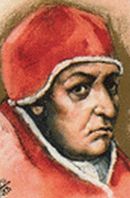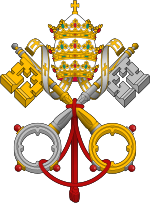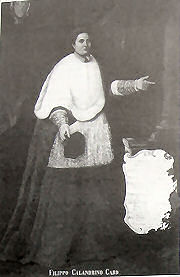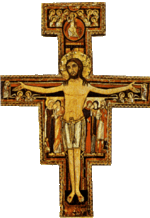Pope Nicholas V
| Nicholas V | |
|---|---|
 |
|
| Papacy began | March 6, 1447 |
| Papacy ended | March 24, 1455 |
| Predecessor | Eugene IV |
| Successor | Callixtus III |
| Personal details | |
| Birth name | Tomaso Parentucelli |
| Born | 15 November 1397 Sarzana, Republic of Genoa |
| Died | 24 March 1455 (aged 57) Rome, Papal States |
| Other Popes named Nicholas | |
Pope Nicholas V (Italian: Niccolò V) (November 15, 1397 – March 24, 1455), born Tommaso Parentucelli, was Pope from March 6, 1447 to his death in 1455.
Contents |
Biography
He was born at Sarzana, Liguria, where his father was a physician. His father died while he was young, but in Florence, Parentucelli became a tutor in the families of the Strozzi and Albizzi, where he met the leading humanist scholars.
He studied at Bologna, gaining a degree in theology in 1422, whereupon the bishop, Niccolò Albergati, was so much struck with his capacities that he took him into his service and gave him the chance to pursue his studies further, by sending him on a tour through Germany, France and England. He was able to collect books, for which he had an intellectual's passion, wherever he went. Some of them survive, with his marginal annotations.
He distinguished himself at the Council of Florence, and in 1444, when his patron died, he was appointed bishop of Bologna in his place. Civic disorders at Bologna were prolonged, so Pope Eugene IV (1431–1447) soon named him as one of the legates sent to Frankfurt to negotiate an understanding between the Papal States and the Holy Roman Empire, regarding undercutting or at least containing the reforming decrees of the Council of Basel (1431–1439).
His successful diplomacy gained him the reward, on his return to Rome, of the title of Cardinal priest of Santa Susanna (December 1446). He was elected Pope in succession to Eugene IV on 6 March of the following year, taking the name of Nicholas V in honour of his early benefactor.
The eight scant years of his pontificate (1447–1455) were important in the political, scientific, and literary history of the world. Politically, he made the Concordat of Vienna, or Aschaffenburg (February 17, 1448) with the German King, Frederick III (1440–1493), by which the decrees of the Council of Basel against papal annates and reservations were abrogated so far as Germany was concerned; and in the following year he secured a still greater tactical triumph, when the resignation of the Antipope Felix V (1439–1449) (7 April) and his own recognition by the rump of the Council of Basel (1431–39), assembled at Lausanne, put an end to the Western Schism (1378–1417).
The next year, 1450, Nicholas V held a Jubilee at Rome; and the offerings of the numerous pilgrims who thronged to Rome gave him the means of furthering the cause of culture in Italy, which he had so much at heart. In March 1452 he crowned Frederick III as Emperor in St. Peter's, the last occasion of the coronation of an Emperor at Rome.
| Papal styles of Pope Nicholas V |
|
|---|---|
 |
|
| Reference style | His Holiness |
| Spoken style | Your Holiness |
| Religious style | Holy Father |
| Posthumous style | None |
Within the city of Rome, Nicholas V introduced the fresh spirit of the Renaissance. His plans were of embellishing the city with new monuments worthy of the capital of the Christian world.
His first care was practical, to reinforce the city's fortifications, cleaning and even paving some main streets and restoring the water supply. The end of ancient Rome is sometimes dated from the destruction of its magnificent array of aqueducts by 6th century invaders. In the Middle Ages Romans depended for water on wells and cisterns, and the poor dipped their water from the yellow Tiber. The Aqua Virgo aqueduct, originally constructed by Agrippa, was restored by Pope Nicholas V, and emptied into a simple basin that Leon Battista Alberti designed, the predecessor of the Trevi Fountain.
But the works on which Nicholas V especially set his heart were the rebuilding of the Vatican and the Borgo district, and St Peter's Basilica, where the reborn glories of the papacy were to be focused.
He got as far as pulling down part of the ancient basilica, made some alterations to the Lateran Palace (of which some frescos by Fra Angelico bear witness), and laid up 2,522 cartloads of marble from the dilapidated Colosseum for use in the later constructions.

Under the generous patronage of Nicholas V, humanism made rapid strides as well. The new humanist learning had been hitherto looked on with suspicion in Rome, a possible source of schism and heresy, an unhealthy interest in paganism. To the contrary, Nicholas V instead employed Lorenzo Valla as a notary and kept hundreds of copyists and scholars, with the special aim of wholesale translations of Greek works, pagan as well as Christian, into Latin, giving as much as ten thousand gulden for a metrical translation of Homer. This industry, coming just before the dawn of printing, contributed enormously to the sudden expansion of the intellectual horizon.
Nicholas V founded a library of nine thousand volumes. The Pope himself was a man of vast erudition, and his friend Aeneas Silvius Piccolomini, later Pope Pius II (1458–1464), said of him that "what he does not know is outside the range of human knowledge."
In 1452, Nicholas V issued the papal bull Dum Diversas, granting the King of Portugal the right to reduce any "Saracens, pagans and any other unbelievers" to hereditary slavery. Dum Diversas legitimised the colonial slave trade that begun around this time with the expeditions by Henry the Navigator to find a sea route to India, which were financed with African slaves. This approval of slavery was reaffirmed and extended in his Romanus Pontifex of 1455.
He was compelled, however, to add that the lustre of his pontificate would be forever dulled by the fall of Constantinople, which the Turks took in 1453. The Pope bitterly felt this catastrophe as a double blow to Christendom and to Greek letters. "It is a second death," wrote Aeneas Silvius, "to Homer and Plato."
Nicholas V preached a crusade, and endeavoured to reconcile the mutual animosities of the Italian states, but without much success. He did not live long enough to see the effect of the Greek scholars armed with unimagined manuscripts, who began to find their way to Italy.
In undertaking these works Nicholas V was moved "to strengthen the weak faith of the populace by the greatness of that which it sees." The Roman populace, however, appreciated neither his motives nor their results, and in 1452 a formidable conspiracy for the overthrow of the papal government, under the leadership of Stefano Porcaro, was discovered and crushed. This revelation of disaffection, together with the fall of Constantinople in 1453, darkened the last years of Pope Nicholas V. "As Thomas of Sarzana," he said, "I had more happiness in a day than now in a whole year."
Pope Nicholas V and slavery
Nicholas issued the bull "Dum Diversas" (June 18, 1452) in response to a request from the Portuguese monarchy. King Alfonso V was conferred the right to "attack, conquer, and subjugate Saracens, Pagans and other enemies of Christ wherever they may be found." It gave title over all lands and possessions seized and permitted the Portuguese to take the inhabitants and consign them to perpetual slavery. The geographical area of the concession given in the bull is not explicit but Richard Raiswell argues that the use of the terms "pagans" and "other enemies of Christ" indicates the scope of the bull was applicable to the newly discovered lands along the west coast of Africa and that the ambiguity of the text was such that it encouraged the Portuguese to extend their explorations further afield. He further argues that the use of crusading language in the bull served to make the Christian-Muslim relationship the model for Africa.[1]
The ownership of the Canary Islands continued to be a source of dispute between Spain and Portugal and Nicholas was asked to settle the matter, ultimately in favor of the Portuguese.[2] The bull issued by Nicholas "Romanus Pontifex" (8 January 1455) reaffirmed "Dum Diveras" and also sanctioned the purchase of black slaves from "the infidel".[3] According to Raiswell (1997) he expressed enthusiasm when recalling the number of slaves that had been captured, brought back to Portugal, baptised and expressed his hope that the entire populations of these new found lands would be converted. Stogre (1992) notes that this bull, perhaps in part due to misleading information provided by the Portuguese, introduced the concept of military force, rather than peaceful evangelisation, for missionary purposes and that it applied to lands that had never previously been subject to Christian ownership, subsequently leading to the "brutal dispossession and enslavement of the indigenous population".[4] The bull also conferred exclusive trading rights to the Portuguese between Morocco and the Indies with the rights to conquer and convert the inhabitants.[5] A significant concession given by Nicholas in a brief issued to King Alfonso in 1454 extended the rights granted to existing territories to all those that might be taken in the future.[6]
It is argued that collectively the two bulls issued by Nicholas gave the Portuguese the rights to acquire slaves along the African coast by force or trade. The concessions given in them were confirmed by bulls issued by Pope Calixtus III "Inter Caetera quae" (1456), Sixtus IV "Aeterni regis" (1481) and Leo X (1514) and they became the models for subsequent bulls issued by Pope Alexander VI : "Eximiae devotionis" (May 3, 1493), "Inter Caetera" (May 4, 1493) and "Dudum Siquidem (September 23, 1493) when he conferred similar rights to Spain relating to the newly discovered lands in the Americas.[7]
See also
- Ludwig von Pastor
- Romanus Pontifex
- Dum Diversas*
References
- "The Historical Encyclopedia of World slavery", Editor Junius P. Rodriguez, ABC-CLIO, 1997, ISBN 0874368855
- "That the world may believe: the development of Papal social thought on aboriginal rights", Michael Stogre S.J, Médiaspaul, 1992, ISBN 2890395499
- "A violent evangelism", Luis N. Rivera, Luis Rivera Pagán [1], Westminster John Knox Press, 1992, ISBN 0664253679
Notes
- ↑ "The Historical encyclopedia of world slavery", Richard Raiswell, p. 469
- ↑ Stogre, p. 65
- ↑ "Black Africans in Renaissance Europe", P. 281
- ↑ Stogre, p. 66
- ↑ The Historical Encyclopedia of world slavery", Richard Raiswell, p. 469
- ↑ "Slavery and the Catholic Church", John Francis Maxwell, p. 55, Barry Rose Publishers, 1975
- ↑ "The Historical Encyclopedia of world slavery", Richard Raiswell, p. 469, "Black Africans in Renaissance Europe", P. 281, Luis N. Rivera, 1992, p. 25
External links
- Encyclopædia Britannica 1911
- Catholic Encyclopedia 1908: Nicholas V.
- Full text of his Papal Bull Pontifex Romanus in English translation :
| Catholic Church titles | ||
|---|---|---|
| Preceded by Eugene IV |
Pope 1447–1455 |
Succeeded by Calixtus III |
|
|||||||||||||||||||||||||||||||||||||||||||||
|
|||||||||||||||||||||||||||||||||||||||||

